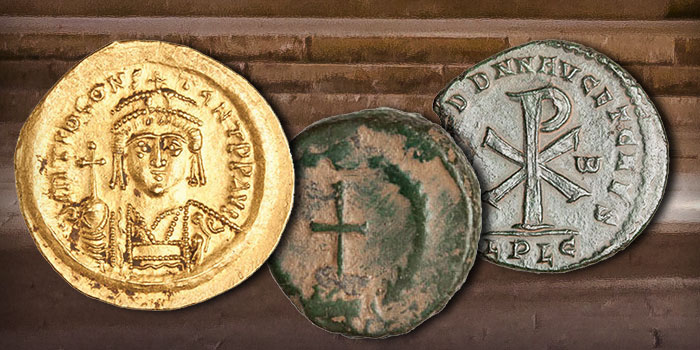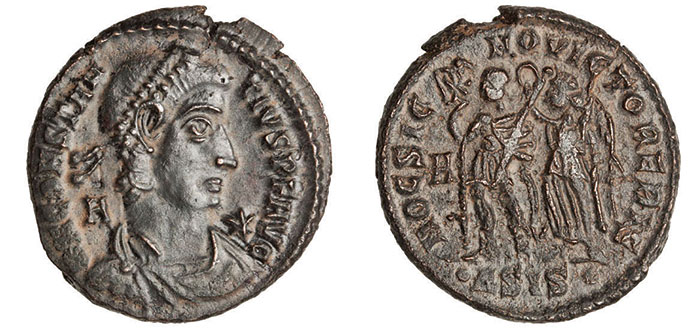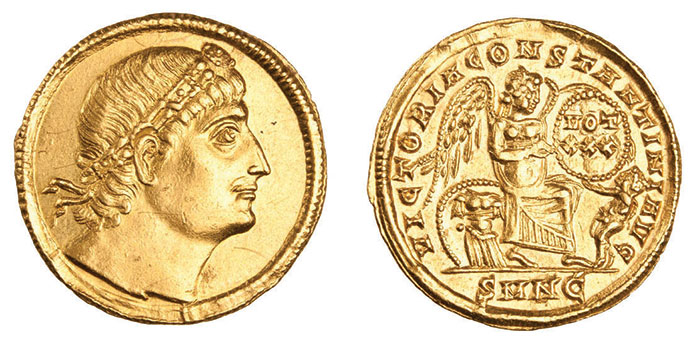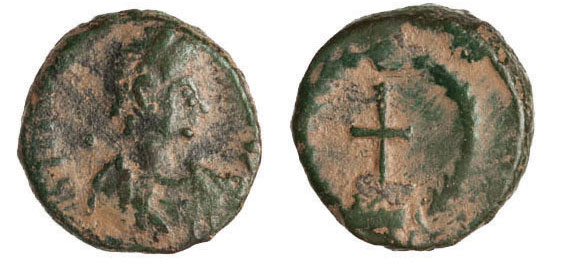
By David Hendin for CoinWeek …..
The cross has been the most recognizable symbol of Christianity for more than 1,600 years. But this was not the case in the first few hundred years after Jesus died. When Jesus was crucified in Jerusalem between around 30 and 33 CE (the exact year is not known), he was one of many thousands of non-Romans who were dispatched by this ghastly form of capital punishment.
Rather than the cross, the earliest Christian symbol used on coins was the superimposed Greek letters chi (X) and rho (P) which looks like this ☧, and represents the first two letters of Christ in Greek (ΧΡΙΣΤΟΣ). This type of monogram is also called a Christogram, and the simple Chi-Rho is one of the oldest examples. It appears on a coin of Constantine the Great (307-337 CE) at the top of a labarum.

The Chi-Rho must not be confused with the symbol that appeared on coins of Herod I nearly 40 years before the birth of Jesus. Herod’s symbol is somewhat enigmatic, but likely abbreviates the first two letters of “tritos”, representing Herod’s third year as king, or 37 BCE, more than three decades before Jesus was born. A similar symbol appears on other Greek coins, including those from Chalkis, with uncertain meanings. “Tetrarch” has also been suggested.
Eusebius (263-339 CE), the Bishop of Caesarea and a contemporary historian, described the labarum as a military standard made from a long pole with a gold spear used to form a cross. On the top of it was “fixed a wreath of gold and precious stones, and within this was the symbol of the Savior’s name: two letters indicating the name of Christ by means of its initial characters, the letter P being intersected by X in its center: and these letters the emperor was in the habit of wearing on his helmet at a later period.”
Constantine the Great was with his army preparing for battle against his rebellious co-emperor Maxentius, on October 28, 312 CE at the Milvian Bridge outside of Rome. Eusebius reports that Constantine told him that in the days before the battle, he looked up at the sun and saw a cross of light above it with the Greek words ’Εν τούτωι νίκα, which translate into Latin as IN HOC SIGNO VINCES, or “In this sign, you will conquer.” At first, Constantine was not sure what it meant, but the next night he had a dream in which Jesus told him that he should use the sign against his enemies. The sign was described by another historian, Lactantius, who said it was a Latin cross with its upper end rounded like a “P”, so it had both the form of a cross and the monogram of Christ’s name–therefore, the Chi-Rho Christogram. A coin of Vetranio (350 CE) struck under Constantius II (337 – 361 CE) reenacts Constantine’s victory.

Following his dream, Constantine ordered the Chi-Rho sign to be inscribed on his soldiers’ helmets and shields. He won the Battle of the Milvian Bridge and claimed the title Imperator. Constantine believed his success was due to divine protection, and this influenced the course of history. In 313 CE, Constantine met with his rival eastern counterpart Licinius at Mediolanum in northern Italy (modern Milan) and they issued the famous Edict of Milan, which allowed Christians to follow the faith of their choosing. This edict abolished penalties for practicing Christianity in the Roman Empire, and all Christian property and churches that had been confiscated were to be returned. From this point forward, Constantine supported the Church, exempted clergymen from certain taxes, and promoted Christians to high office.

It’s not clear whether Constantine himself became a Christian, but he did adopt Jesus as his patron despite the fact that his subjects and his soldiers remained predominantly pagan. Further acknowledging the importance of the Christian religion, Constantine convened the 325 CE Council of Nicea that established the equality of the Father, the Son, and the Holy Spirit in the Holy Trinity, and established that only the Son was incarnate as Jesus Christ.
Constantine’s mother, Helena, had not only converted to Christianity but was so excited by her spiritual experience that it enticed her to make a pilgrimage, circa 326 CE, to Judea, where she could visit all of the sites that were important in the life of Jesus.
One of Constantine’s most famous building projects, initiated by Helena, was the Church of the Holy Sepulcher in Jerusalem. Tradition holds that the site of the crucifixion was identified by Helena during her visit to Jerusalem. Today’s church is built on the foundations of the one from Constantine’s time.

The usurper Magnentius (350-353 CE) was popular in some provinces partly because he was increasingly tolerant to both Christians and pagans in the wake of Constantine’s successors. One coin of Magnentius features a large Christogram flanked by the first and last letters of the Greek alphabet “the alpha and the omega, the beginning and the end,” as Jesus refers to himself in the Book of Revelation (1:8, 21:6, 22:13).

By the end of the fourth century, Christianity had become well-established within the Roman Empire in both the East and the West. Christianity finally became the state religion of the Roman Empire on 27 February 380 when Theodosius I, Gratian, and Valentinian II jointly issued the Edict of Thessalonica.
The familiar Christian cross did not become widely used as a principal symbol of Christianity until the late fourth century CE. The cross may have evolved from the earlier labarum with its crossbar and Chi-Rho on top. At this time the symbol of the cross became closely associated with the cross upon which Jesus was crucified by the Romans on the Golgotha Hill in Jerusalem. The cross became the pre-eminent symbol of Christianity, used to decorate rings, amulets, oil lamps, scale weights, art, and architecture.
Romans did not have any inherent affinity to the cross as a religious object, since traditionally it had been a symbol of criminal execution. Gradually, however, the cross as a symbol of Christianity began to appear on coins of Theodosius and his empresses and successors. The first coin to feature the Christian Cross as the central motif was apparently a small bronze struck under Theodosius II, emperor of the Eastern Roman Empire in Constantinople (402-450 CE).

Numerous Byzantine rulers featured crosses on their coin. A gold solidus of Tiberius II Constantine (578-582 CE), for example, showed the emperor holding a scepter surmounted by a cross.

The first portrait of Jesus was used on a coin struck in 692 CE under Justinian II as a show of his religious devotion. This was nearly 300 years after the Christian cross began to appear on Roman coins. Around Justinian II’s numismatic portrait of Jesus was the Latin legend, “Jesus Christ, King of Kings”. The issuance of this coin may have been a result of Canon 82 of the Council in Trullo, held in 692 CE, which decreed, “the figure in human form of the Lamb who takes away the sin of the world, Christ our God, be henceforth exhibited in images, instead of the ancient lamb…” Justinian II depicted himself on the reverse, standing, with a cross and the inscription “Justinian, Servant of Christ”.

© 2021 by David Hendin
Parts of some CoinWeek articles may be adapted from my previous articles or my Guide to Biblical Coins.
* * *
David Hendin is First Vice President and an Adjunct Curator at the American Numismatic Society (ANS). Send him your questions at [email protected] and he will try to answer questions of general interest in this space in the future.





Oh it’s definitely silver